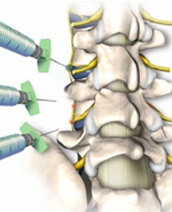Sympathetic Nerve Blocks & RFTC

A Sympathetic Nerve Block is an injection of local anesthetic and cortisone in the “sympathetic nerve tissue”, the nerves which are a part of Sympathetic Nervous System. The nerves are located on either side of the spine, in the back.
What is the purpose?
The injection blocks the Sympathetic Nerves. This may in turn reduce pain, swelling, color, and sweating changes in the lower extremity and may improve mobility. It is done as a part of the treatment of Reflex Sympathetic Dystrophy (RSD), Sympathetic Maintained Pain, and Complex Regional Pain Syndrome.
How long does the injection take?
The actual injection takes only a few minutes.
What is actually injected?
The injection consists of a local anesthetic (like lidocaine or bupivacaine) and cortisone.
Will the injection hurt?
The procedure involves inserting a needle through skin and deeper tissues (like a “tetanus shot”). So, there is some discomfort involved. However, we may numb the skin and deeper tissues with a local anesthetic using a very thin needle before inserting the actual block needle. Most of the patients also receive intravenous sedation and analgesia, which makes the procedure easy to tolerate.
Will I be “put out” for this procedure?
No. This procedure is done under local anesthesia. Most of the patients also receive intravenous sedation and analgesia, which makes the procedure easy to tolerate. The amount of sedation given generally depends upon the patient tolerance.
How is the injection performed?
It is done with the patient lying on stomach. The patients are monitored with a blood pressure cuff and blood oxygen-monitoring device. The skin on back is cleaned with antiseptic solution and then the injection is carried out. Fluoroscopy (X-rays) is used to guide the needle(s) in the proper position.
What should I expect after the injection?
Immediately after the injection, you may feel your lower extremity getting warm. In addition, you may notice that your pain may be gone or quite less. You may also notice some weakness and/or numbness in the leg, which is temporary.

